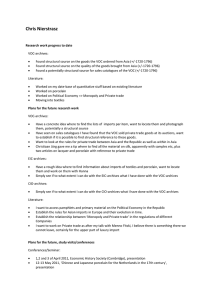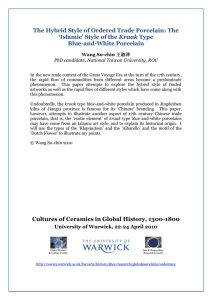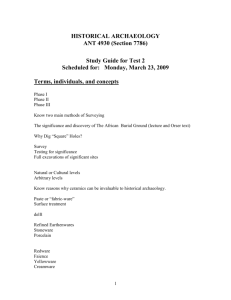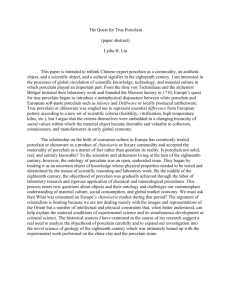During the seminar in Leeuwarden I talked about the importance... East India Company (VOC, hereafter) in the 17
advertisement
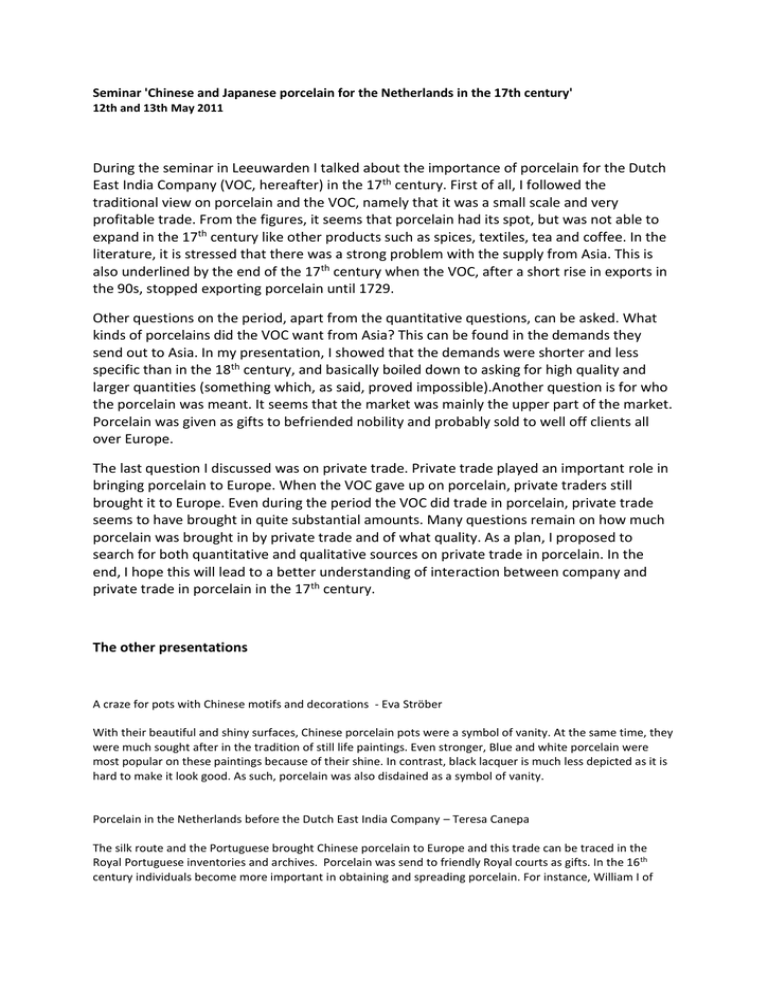
Seminar 'Chinese and Japanese porcelain for the Netherlands in the 17th century' 12th and 13th May 2011 During the seminar in Leeuwarden I talked about the importance of porcelain for the Dutch East India Company (VOC, hereafter) in the 17th century. First of all, I followed the traditional view on porcelain and the VOC, namely that it was a small scale and very profitable trade. From the figures, it seems that porcelain had its spot, but was not able to expand in the 17th century like other products such as spices, textiles, tea and coffee. In the literature, it is stressed that there was a strong problem with the supply from Asia. This is also underlined by the end of the 17th century when the VOC, after a short rise in exports in the 90s, stopped exporting porcelain until 1729. Other questions on the period, apart from the quantitative questions, can be asked. What kinds of porcelains did the VOC want from Asia? This can be found in the demands they send out to Asia. In my presentation, I showed that the demands were shorter and less specific than in the 18th century, and basically boiled down to asking for high quality and larger quantities (something which, as said, proved impossible).Another question is for who the porcelain was meant. It seems that the market was mainly the upper part of the market. Porcelain was given as gifts to befriended nobility and probably sold to well off clients all over Europe. The last question I discussed was on private trade. Private trade played an important role in bringing porcelain to Europe. When the VOC gave up on porcelain, private traders still brought it to Europe. Even during the period the VOC did trade in porcelain, private trade seems to have brought in quite substantial amounts. Many questions remain on how much porcelain was brought in by private trade and of what quality. As a plan, I proposed to search for both quantitative and qualitative sources on private trade in porcelain. In the end, I hope this will lead to a better understanding of interaction between company and private trade in porcelain in the 17th century. The other presentations A craze for pots with Chinese motifs and decorations - Eva Ströber With their beautiful and shiny surfaces, Chinese porcelain pots were a symbol of vanity. At the same time, they were much sought after in the tradition of still life paintings. Even stronger, Blue and white porcelain were most popular on these paintings because of their shine. In contrast, black lacquer is much less depicted as it is hard to make it look good. As such, porcelain was also disdained as a symbol of vanity. Porcelain in the Netherlands before the Dutch East India Company – Teresa Canepa The silk route and the Portuguese brought Chinese porcelain to Europe and this trade can be traced in the Royal Portuguese inventories and archives. Porcelain was send to friendly Royal courts as gifts. In the 16 th century individuals become more important in obtaining and spreading porcelain. For instance, William I of Orange, while at the Spanish court had a taste for porcelain and during the Early Dutch expeditions porcelain was sought after. Technical innovations, the introduction of colour - Christiaan Jörg Blue and White porcelain was made for export as it was relatively easy to make. At the same time, Blue and white tied into existing European precious objects. White is the symbol of purity, while Blue is the sky or heaven, so it seems it ties into religion. At the same time, polychrome porcelain was widely available in South China. At the same time, Europeans jumped on big jars with lids, often polychrome. When production shifted to the Japan, polychrome was produced especially for the Dutch. But, they used overglazed blue instead of underglazed. Then, when production shifted back to China, Chinese started producing overglazed blue too. OVerglazed blue is difficult to do.
